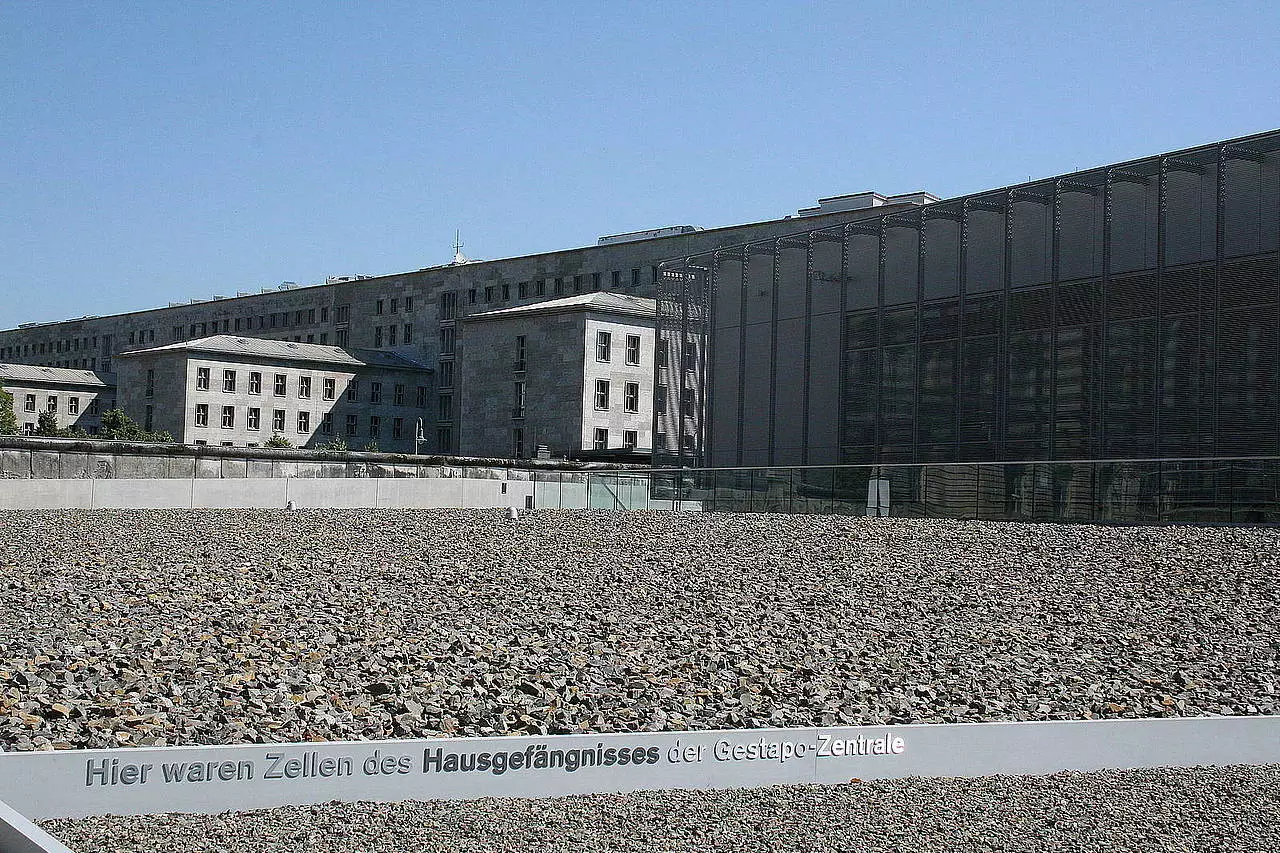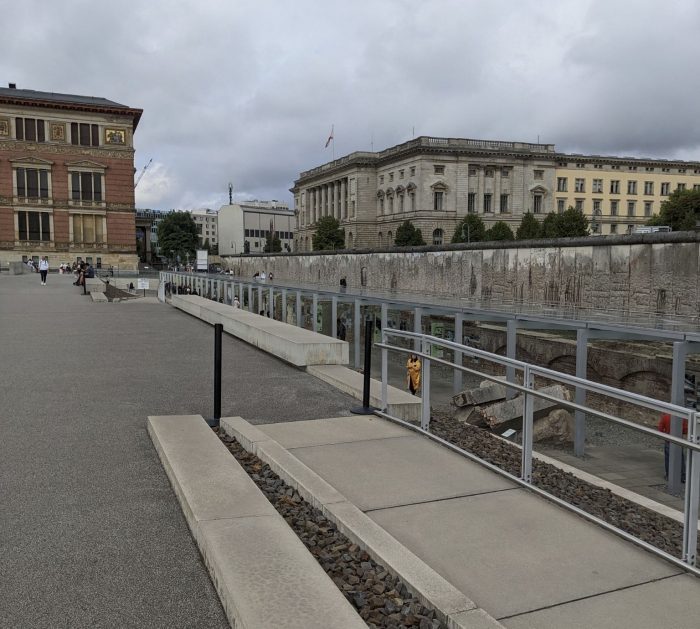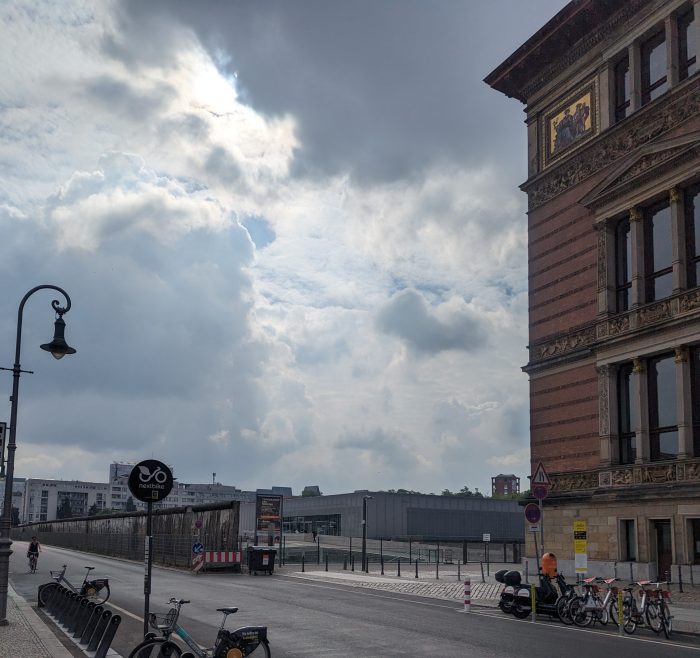Pre-Site Visit Reflections:
Described as once being “the most feared address” in Berlin, the site on which the Topography of Terror now stands serves as an example of the city’s multilayered history (Connolly). In telling the stories of both perpetrator and victim, this museum and memorial site shows us the challenges memorial work meets in terms of how to represent historical atrocities and also incorporate the physical history of the site itself.
The Reich Security Main Office (Reichssicherheitshauptamt) was inaugurated in 1939 following the start of WWII with Heinrich Himmler as leader (“History before 1945”). The office included several formerly independent organizations, including the Gestapo, SS, and SA. These departments were housed in a former school of arts in Berlin, and contained offices and holding cells where prisoners were interrogated and tortured). The building was significantly damaged in World War II. Following the war, the site was used as a construction dumping ground, as well as an area for people without a license to practice driving (“History after 1945”). Starting in the 1970s, public awareness began to increase about the history of the site and plans for a memorial were initiated. A smaller documentation centre opened in 1987, before many design competitions were held, resulting in a new museum and memorial area being completed in 2010.
When I visited The Topography of Terror a few summers ago, I was struck by the vast size of the total site, as well as the various exhibits both inside and outside the museum. Within the museum stood a large permanent exhibit describing the Nazi rise to power, their plans for and executions of genocide, and the post-war pursual and persecution of the architects of these plans. The exhibits were almost solely comprised of large blocks of text in German and English and photographs; I found this had a strangely alienating effect on me that distanced me as opposed to other museums that try to create an immersive and emotional experience through sound, touch, etc. However, I think this helped add to the reputability and more factual tone of the museum. I was also intrigued by the outdoor exhibit featuring the excavated ruins of the former building’s basement, as well as remnants of the Berlin Wall. Before these artifacts stood large information plaques that illuminated other aspects of the Nazi period.
I am interested to return to this site and investigate more of the entire site (not just inside the museum), and am also curious how the design of the building and grounds affect my path and experience.
Post-Site Visit Reflections:
The time we spent at the Topography of Terror was quite short, but it still provided me with much insight because of its surrounding context and opportunity this visit provided for comparisons with the other sites we have seen.
Given that we arrived before both the information centre and site grounds were open to the public, and we had an appointment with the Canadian ambassador to Germany immediately afterwards, we had only a few minutes to view the site through a metal gate. I was struck by the imposing size of the Berlin Wall segments that demarcate the site’s limits with the street; because very few continuous segments of the wall remain, this area served as a reminder of the wall’s former presence. Along these lines, I was surprised at the highly intentional and impactful manner in which the preserved previous uses of this site interacted in size, material, and even colour. Beside the wall were semi-excavated red brick ruins, followed by an expanse of small rocks (this would later connect to the rocks that make up the foundation of the Ravensbrück memorial site), and the modernistic and austere-looking information centre taking up the remaining space. The interaction of “natural” landscape and human-made structures at the Topography of Terror contained similarities and differences to our other sites. Like the Memorial to the Murdered Jews of Europe, the site is a combination of composed outdoor architecture and an indoor learning centre, while the Topography of Terror is different because the history the site was remembering had occurred there. Its use of rocks and original foundations was similar to the Sachsenhausen and Ravensbrück camps, but I had the sense that the camps were attempting to reconstruct their historical states, while the Topography of Terror featured contemporary architecture with its new building and large rock-laden field.
The path from the Topography of Terror to the embassy led us past a building that was also of significant importance during the Nazi and GDR periods: the Detlev-Rohwedder-Haus. I enjoyed reading the large comic posted on the building’s gate which discussed an East German family’s use of a zipline to escape to the West. To me, this was another example of the layered history that is present in Berlin. This building is now used for administrative purposes, and it is curious to see its largely intact state compared to the destroyed and redesigned Topography of Terror site.
Speaking with a few peers who visited the Topography of Terror later, I noted that their reactions centred around the significant amount of text in the museum. When I visited this museum in 2022, I found this to be true as well. Having now visited more sites on this field school, I have realized that embodied experiences that reach more of my senses tend to be much more impactful than images and text on a wall, and can also generate more interest in the content. An interesting point of comparison with the Topography of Terror is the Berlin Story Bunker, which also tells the story of the Nazi rise to power but is housed within a reconstruction of the late-WWII so-called “Führerbunker”. Ultimately, both examples point to a problematic and yet important element of Holocaust memorialization: the task of creating a site focused on the perpetrators of war and genocide.
Citations:
Connolly, Kate. “Nazi Control Room Reopens as Topography of Terror Museum in Berlin.” The Guardian, Guardian News and Media, 6 May 2010, www.theguardian.com/world/2010/may/06/topography-terror-nazi-museum-berlin.
“History after 1945.” Topographie Des Terrors, www.topographie.de/en/the-hoistoric-site/history-after-1945. Accessed 13 May 2024.
“History before 1945.” Topographie Des Terrors, www.topographie.de/en/the-hoistoric-site/history-before-1945. Accessed 13 May 2024.



